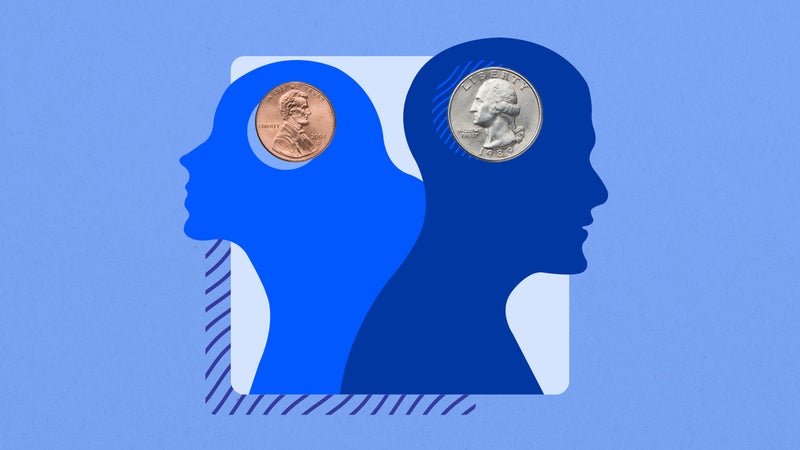Building financial independence for women through financial literacy

The Bankrate promise
At Bankrate we strive to help you make smarter financial decisions. While we adhere to strict , this post may contain references to products from our partners. Here's an explanation for .
Women’s participation in the economy has risen steadily over the decades when it comes to education, workforce experience and increased earnings. However, significant challenges remain that include a wage gap between women and men, as well as other barriers women face in growing their wealth.
When it comes to financial literacy, surveys have shown women feel less confidence than their male counterparts. In a 2021 study by the Global Financial Literacy Excellence Center, women were found to answer a financial literacy question disproportionately with “do not know,” yet when that answer option was removed, they often chose the correct answer.
Those who are financially literate are able to use their knowledge and skills to effectively manage their money when it comes to budgeting, investing, and saving for emergencies, retirement and other goals.
Owning a home and getting a college degree are part of the American dream for 76 percent and 37 percent of American women, respectively, according to Bankrate. Barriers to achieving these goals, however, can include lower confidence in financial literacy, as well as the gender wage gap and lower savings rates.
Key financial literacy statistics
- Around 1 in 4 working women (26 percent) were not contributing to their retirement in 2022 or 2023, as of August 2023. Among working women saving for retirement, nearly 30 percent don’t know how much they need to retire comfortably (compared with 20 percent of working men).
- Women make up 53 percent of the entry-level banking workforce but less than one-third of positions at SVP and C-suite levels.
- Nearly half (48 percent) of women are confident about their finances, although only 28 percent feel empowered to take action.
- Just over half of women (53 percent) are confident with managing investments, and less than half (44 percent) are comfortable creating a diversified portfolio.
- Female workers earned just 83 cents for every dollar a male worker was paid in 2022.
Sources: Bankrate’s retirement savings survey, McKinsey & Company Women in the Workplace report, Bank of America’s Women, Money, Confidence study, U.S. Bureau of Labor Statistics Current Population Survey
Research on gender financial literacy gap
Lack of financial literacy could put individuals at risk for getting into excessive debt, having an inadequate emergency fund or not saving enough for retirement. A 2022 TIAA Institute financial literacy survey found that women answered an average of only 45 percent of personal finance questions correctly, whereas men fared significantly better with 55 percent correct on average. Survey questions included those on saving, investing and borrowing.
The TIAA Institute survey also found that women with low financial literacy are five times more likely to have difficulty making ends meet, three times more likely to be debt constrained, and three times more likely to be unable to handle a $2,000 financial shock.
Another financial area in which research has shown women to be behind men is that of retirement literacy. A 2023 study by the BMO Real Financial Progress Index found just 53 percent of women feel confident about retiring at their target range, compared with a significantly higher 66 percent of men. What’s more, 74 percent of women have no financial plan in place to reach their goals, compared with 58 percent of men, the study found.
Impact of lower financial literacy rates on women
Due to having lower financial literacy rates than men, women may ultimately face obstacles when it comes to handling living expenses, building wealth, and managing loans and credit card debt.
The main way women can liberate themselves from the chains of major economic barriers — whether it’s pricey child care or the gender pay gap — is by growing their financial wealth.— SARAH FOSTER | BANKRATE U.S. ECONOMY REPORTER
Some things Foster says women can do to brush up on their finances include:
- Practicing the zero-based budget model to ensure every dollar is put to work toward saving, investing or essentials
- Knowing how much you can afford to spend on discretionary purchases to avoid overspending
- Investing in the financial markets to ensure your wealth beats inflation over time
- Having a high-yield savings account, which offers market-like returns without any market risk
Building wealth
Retirement: Studies have found women are behind men when it comes to saving for retirement. For instance, a 2023 Bank of America study found men have a 50 percent greater average 401(k) balance than women ($89,000 vs. $59,000).
“Taking advantage of an employer-sponsored retirement plan such as a 401(k) can also come with major tax savings,” Bankrate’s Foster says. “Contribute up until your employer match, or better yet, max out your annual contributions. If you want to go the extra mile, consider adding a traditional or Roth IRA to your portfolio.”
Savings: When it comes to saving money, women put away less than half the amount men saved in 2022, with women saving an average of $3,146, compared to the $7,007 saved by men, according to New York Life’s 2023 Wealth Watch survey.
Women are more likely than men to feel stress over their finances. More than half of women (56 percent) say money has a negative impact on their mental health, compared with 47 percent of men, according to Bankrate.
“The worst mistake you can make is keeping too much money in a checking account, where it won’t benefit from the highest savings yields in over a decade (if you pick an online bank, that is) or compound interest in a retirement account,” Bankrate’s Foster says.
Investing: There would be at least an extra $3.22 trillion assets under management today if women were to invest at the same rate as men, according to a 2021 study by BNY Mellon Investment Management. A perceived income hurdle may be one impediment to investing for women, as U.S. women on average believe they need more than $6,000 of disposable income each month before they can start investing, the study found.
A 2021 Fidelity study found that just 33 percent of women felt confident in their ability to make decisions regarding investing, and just 42 percent had confidence in their ability to build up long-term savings, such as for retirement.
Cost of living and purchases
Emergency savings: More than one-third (36 percent) of U.S. adults have more credit card debt than emergency savings, according to Bankrate. In fact, women are more likely than men to have more credit card debt than emergency savings. Two in five (40 percent) of women reported having more credit card debt than emergency savings, compared with just 31 percent of men, per Bankrate’s survey.
Bankrate’s Foster advises taking advantage of a savings account that earns a competitive rate. “High-yield savings accounts are offering Americans market-like returns without any market risk.”
Cost of living affordability: For every dollar a man earns, women earn just 83 cents, which can make it more difficult for women to afford basic cost of living expenses, such as housing. Well more than half (61 percent) of American women say concerns about cost of living have increased, compared to 54 percent of men, based on a 2024 BMO Financial Group report.
More than two thirds (38 percent) of women identified monthly bills as a barrier to making real financial progress, compared with 30 percent of men, according to the BMO Financial Group Report. It also found that 67 percent of men say keeping up with the bills causes financial anxiety, compared with 60 percent of men.
Loans and approvals for big purchases
Loans: A 2020 Experian report found men carry more debt than women in most categories, including having 20 percent more personal loan debt, 16 percent more auto loan debt and nearly 10 percent more mortgage debt. The one exception was student loan debt, of which women carry nearly 3 percent more than men.
When it comes to borrowing money for college, nearly 66 percent of all student loan debt belongs to women, according to the Education Data Initiative. It also reported the average student debt for women in the U.S. is $31,726, and the average women’s monthly debt repayment amount is $307.
Credit availability: In addition to the gender pay gap, a gap exists between men and women regarding bank card credit limits, according to some data. A 2021 report from the Federal Reserve Bank of Philadelphia found that among men and women who are sole mortgage applicants and successfully originated a mortgage, “the unexplained gender difference in bankcard limits is $1,323, with male borrowers having higher limits than female borrowers.”
On average, men have just $125 more credit card debt than women, per the 2020 Experian report. While the average debt is similar between genders, men’s and women’s views may differ in regard to reasons for taking on debt. Men were found to have a higher tolerance than women for using debt to obtain luxury items, according to research published in The Journal of Consumer Affairs in 2018. It found women were more accepting of using debt for purposes like bridging income gaps.
Melisse Burstein, CPA and partner at Miami-based account firm Gerson Preston, offers the following advice on getting out of debt:
- Make a plan: Create a plan to pay off debts, starting with the ones that have the highest interest rates.
- Cut expenses: Look for ways to reduce expenses, such as cutting back on dining out or entertainment.
- Increase income: Consider taking on a part-time job or freelance work to increase income and pay down debts faster.
- Seek professional help: If debts are overwhelming, consider seeking help from a financial professional who can provide advice on debt consolidation or debt management plans.
- Don’t borrow your way out of debt: Try not to reduce one debt by creating a new one. For example, it may seem beneficial to take out a 401(k) loan, but the fees and taxes upon the withdrawal can be exorbitant.
If you’re shopping for a new credit card, consider one that helps you earn cash back. “Just make sure you don’t have any credit card debt,” Bankrate’s Foster says. “With interest rates on credit cards hovering at the highest levels on record, it doesn’t make sense to pay a 20 percent interest rate for 3-5 percent cash back.”
Bottom line
For women looking to build up an emergency fund or get out of debt, getting started is often the hardest part. One important way to take control of your finances is creating a budget so you can keep track of how much money comes in and goes out each month. You can use pen and paper, a spreadsheet on your computer or a budgeting app. Having a budget will help you make decisions about how to spend any money that’s left over after you factor in your living expenses.
Investing is a way to grow one’s wealth and outpace inflation, and investment accounts can be opened in the form of retirement accounts, investment funds, or options such as stocks, bonds and mutual funds.
“In general women should try and start learning about personal finances while they are still in school,” Burstein says. “Financial education can and will play a pivotal role in supporting women who may experience personal crises and can also give them the strength to leave unhealthy relationships, confident that they can economically support themselves.”
Organizations women can turn to for financial education and resources include the Financial Literacy Organization for Women and Girls (FLOW) and the Women’s Institute for Financial Education (WIFE).
-
All figures, unless otherwise stated, are from YouGov Plc. Total sample size was 2,527 US adults, of whom 1,301 are working full-time, part-time or temporarily unemployed. Fieldwork was undertaken between 23rd – 25th August 2023. The survey was carried out online. The figures have been weighted and are representative of all US adults (aged 18+). The survey was carried out online and meets rigorous quality standards. It employed a non-probability-based sample using both quotas upfront during collection and then a weighting scheme on the back end designed and proven to provide nationally representative results.
Bankrate commissioned YouGov Plc to conduct the survey. All figures, unless otherwise stated, are from YouGov Plc. Total sample size was 2,365 U.S. adults, among whom 1,232 say concerns about money have a negative impact on their mental health. Fieldwork was undertaken on April 12-14, 2023. The survey was carried out online and meets rigorous quality standards. It employed a non-probability-based sample using both quotas upfront during collection and then a weighting scheme on the back end designed and proven to provide nationally representative results.
The study (that was conducted January 2024) was conducted by SSRS on its Opinion Panel Omnibus platform. The SSRS Opinion Panel Omnibus is a national, twice-per-month, probability-based survey. Data collection was conducted from January 19 – January 21, 2024 among a sample of 1031 respondents. The survey was conducted via web (n=1001) and telephone (n=30) and administered in English (n=1005) and Spanish (n=26). The margin of error for total respondents is +/- 3.6 percentage points at the 95% confidence level. All SSRS Opinion Panel Omnibus data are weighted to represent the target population of U.S. adults ages 18 or older.


